
FACULTY OF ARTS AND SCIENCES
Department of Sociology
GEAR 213 | Course Introduction and Application Information
| Course Name |
Art Movements and Artists of the 20th Century
|
|
Code
|
Semester
|
Theory
(hour/week) |
Application/Lab
(hour/week) |
Local Credits
|
ECTS
|
|
GEAR 213
|
Fall/Spring
|
3
|
0
|
3
|
4
|
| Prerequisites |
None
|
|||||
| Course Language |
English
|
|||||
| Course Type |
Service Course
|
|||||
| Course Level |
First Cycle
|
|||||
| Mode of Delivery | - | |||||
| Teaching Methods and Techniques of the Course | DiscussionGroup WorkLecture / Presentation | |||||
| Course Coordinator | - | |||||
| Course Lecturer(s) | ||||||
| Assistant(s) | - | |||||
| Course Objectives | The objective of this course is to emphasize a conceptual understanding of art movements in the 20th century. |
| Learning Outcomes |
The students who succeeded in this course;
|
| Course Description | Students will be able to identify different art movements, will gain basic understanding of each work’s possible concept, significance and style and will be able to examine selected art works from the 20th century. |
|
|
Core Courses | |
| Major Area Courses | ||
| Supportive Courses | ||
| Media and Management Skills Courses | ||
| Transferable Skill Courses |
WEEKLY SUBJECTS AND RELATED PREPARATION STUDIES
| Week | Subjects | Related Preparation |
| 1 | Introduction: Brief information about the art journey of humanity. The changing conditions which lay foundation for Modernism. | Weston, R. (1996), Modernism, Phaidon Press, pp: 8-19, video on Industrial Revolution. |
| 2 | Last decades of 19th century. Impressionism, Post Impressionism, Symbolism, Art Nouveau | Kleiner, Fred, et.al, (2004). Gardner’s Art Through the Ages. Thomson Wadsworth, pp. 919-930. |
| 3 | Cubism, Primitivism and Futurism | Kleiner, Fred, et.al, (2004). Gardner’s Art Through the Ages. Thomson Wadsworth, pp. 959-967. |
| 4 | Expressionism, Fauvism | Kleiner, Fred, et.al, (2004). Gardner’s Art Through the Ages. Thomson Wadsworth, pp. 919-930. Buchholz, E.L., Bühler G., Hille K., Kaeppele, S., Stotland I. (2007). Art –The History of Modern Art, Peter Delius Verlag, pp. 415-459 |
| 5 | Bauhaus, Constructivism | Weston, R. (1996), Modernism, Phaidon Press, pp: 119-137; Shiner, L. (2001). The Invention of Art. Chicago, The University of Chicago Press. pp.246-268. |
| 6 | New Experiments: Dada, Suprematism, Neo-Plasticism | Philips, S. (2018) isms: Understanding Modern Art, Herbert Press. Pp.52-56 Buchholz, E.L., Bühler G., Hille K., Kaeppele, S., Stotland I. (2007). Art –The History of Modern Art, Peter Delius Verlag. |
| 7 | Surrealism | Philips, S. (2018) isms: Understanding Modern Art, Herbert Press.pp.64-67 Buchholz, E.L., Bühler G., Hille K., Kaeppele, S., Stotland I. (2007). Art –The History of Modern Art, Peter Delius Verlag. |
| 8 | Midterm | |
| 9 | Realism: Social Realism, Kitchen Sink Realism | Philips, S. (2018) isms: Understanding Modern Art, Herbert Press. |
| 10 | Abstract Expressionism. | Philips, S. (2018) isms: Understanding Modern Art, Herbert Press. Buchholz, E.L., Bühler G., Hille K., Kaeppele, S., Stotland I. (2007). Art –The History of Modern Art, Peter Delius Verlag. |
| 11 | Pop Art, Op Art, Conceptual Art | Buchholz, E.L., Bühler G., Hille K., Kaeppele, S., Stotland I. (2007). Art –The History of Modern Art, Peter Delius Verlag. Adorno, W.T., Culture Industry, Routledge Classics “The Schema of Mass Culture” |
| 12 | Post Modernism. Feminist Art. | Broude, N., Garrard M. D., (1994) The Power of Feminist Art, Thames and Hudson, pp. 10-29. |
| 13 | Live Art: Installation, Performance and Dance | Videos |
| 14 | Environmental art, Technological Art. | Invitation to the Gallery pp.281-285 |
| 15 | Review | |
| 16 | FINAL EXAM |
| Course Notes/Textbooks | Adorno, W.T., Culture Industry, Routledge Classics.
|
| Suggested Readings/Materials | https://www.khanacademy.org/ |
EVALUATION SYSTEM
| Semester Activities | Number | Weigthing |
| Participation |
1
|
10
|
| Laboratory / Application | ||
| Field Work | ||
| Quizzes / Studio Critiques | ||
| Portfolio | ||
| Homework / Assignments |
1
|
10
|
| Presentation / Jury |
1
|
20
|
| Project | ||
| Seminar / Workshop | ||
| Oral Exams | ||
| Midterm |
1
|
30
|
| Final Exam |
1
|
30
|
| Total |
| Weighting of Semester Activities on the Final Grade |
4
|
70
|
| Weighting of End-of-Semester Activities on the Final Grade |
1
|
30
|
| Total |
ECTS / WORKLOAD TABLE
| Semester Activities | Number | Duration (Hours) | Workload |
|---|---|---|---|
| Theoretical Course Hours (Including exam week: 16 x total hours) |
16
|
3
|
48
|
| Laboratory / Application Hours (Including exam week: '.16.' x total hours) |
16
|
0
|
|
| Study Hours Out of Class |
10
|
3
|
30
|
| Field Work |
0
|
||
| Quizzes / Studio Critiques |
0
|
||
| Portfolio |
0
|
||
| Homework / Assignments |
1
|
10
|
10
|
| Presentation / Jury |
1
|
10
|
10
|
| Project |
0
|
||
| Seminar / Workshop |
0
|
||
| Oral Exam |
0
|
||
| Midterms |
1
|
10
|
10
|
| Final Exam |
1
|
15
|
15
|
| Total |
123
|
COURSE LEARNING OUTCOMES AND PROGRAM QUALIFICATIONS RELATIONSHIP
|
#
|
Program Competencies/Outcomes |
* Contribution Level
|
||||
|
1
|
2
|
3
|
4
|
5
|
||
| 1 | To have the knowledge of classical and contemporary theories in sociology, and be able to comparatively analyze these theories. |
|||||
| 2 | To have the knowledge of main methodological approaches in sociology as well as social research and data analysis methods. |
|||||
| 3 | To have knowledge in the fields of general sociology, sociology of institutions, social structure and change, and applied sociology. |
|||||
| 4 | To be able to determine the appropriate methods in the design of the planning stage and conclusion of a sociological project, individually or as part of a team. |
|||||
| 5 | To be able to diagnose the social dynamics behind personal problems by using sociological imagination. |
|||||
| 6 | To be able to define social problems at local, national, and global level, and offer new policies for solutions. |
|||||
| 7 | To be able to apply commonly-used computer programs for data collection and analysis in sociological research. |
|||||
| 8 | To be able to develop a socially responsible, scientific and ethical perspective regarding the collection, analysis, interpretation and presentation of data. |
|||||
| 9 | To be able to analyze different aspects of the social world by drawing on the knowledge produced by other disciplines of the social sciences. |
|||||
| 10 | To be able to constantly renew herself/himself professionally by following scientific and technological developments in sociology and social research. |
|||||
| 11 | To be able to collect sociological data and communicate with sociologists and other social scientists in a foreign language ("European Language Portfolio Global Scale", Level B1). |
|||||
| 12 | To be able to speak a second foreign at a medium level of fluency efficiently. |
|||||
| 13 | To be able to relate the knowledge accumulated throughout the human history to their field of expertise. |
|||||
*1 Lowest, 2 Low, 3 Average, 4 High, 5 Highest
NEWS |ALL NEWS
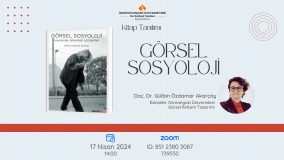
Book Presentation and Talk: Visual Sociology
Department of Sociology invites you to the Book Presentation and Talk event with Gülbin Özdamar Akarçay, the author of “Visual Sociology". Date:
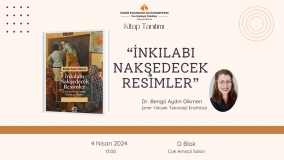
Book Presentation and Talk: Painting the Revolution
Department of Sociology invites you to the Book Presentation and Talk event with Dr. Bengü Aydın Dikmen, the author of “Painting the
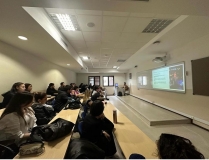
We welcomed ethnomusicologist Onur Sönmez.
We held our sociology seminar where we hosted ethnomusicologist Onur Sönmez. We thank him very much for this detailed and interesting presentation.
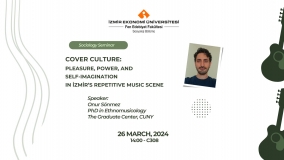
Cover Culture: Pleasure, Power, and Self-Imagination in İzmir’s Repetitive Music Scene
You are cordially invited to the Sociology Seminar where we will host Dr. Onur Sönmez. Onur Sönmez has a PhD in ethnomusicology
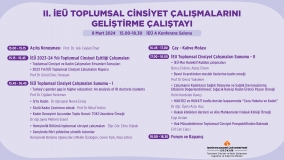
II. IUE GENDER STUDIES DEVELOPMENT WORKSHOP (EKOKAM- Gender and Women’s Studies Research and Application Center)
Research Assistant Helin Kardelen Kavuş attended the “II. IUE Gender Studies Development Workshop” on March 8, 2024, International Women's Day. Organized by EKOKAM, the workshop
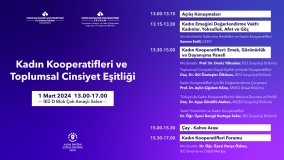
Women’s Cooperatives and Gender Equality
You are cordially invited to "Women's Cooperatives and Gender Equality", which will be co-organized by IUE EKOKAM, the Department of Sociology, and
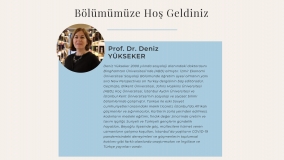
Welcoming Our New Faculty Member: Professor Deniz Yükseker
We are proud to welcome and introduce our newest faculty member: Professor Deniz Yükseker. We wish her all the best and success
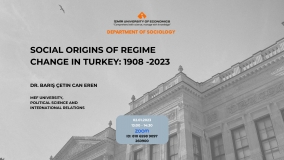
Sociology Seminar: Social Origins of Regime Change in Turkey: 1908 -2023
Department of Sociology cordially invites you to a seminar on "Social Origins of Regime Change in Turkey: 1908 - 2023" by Dr.



